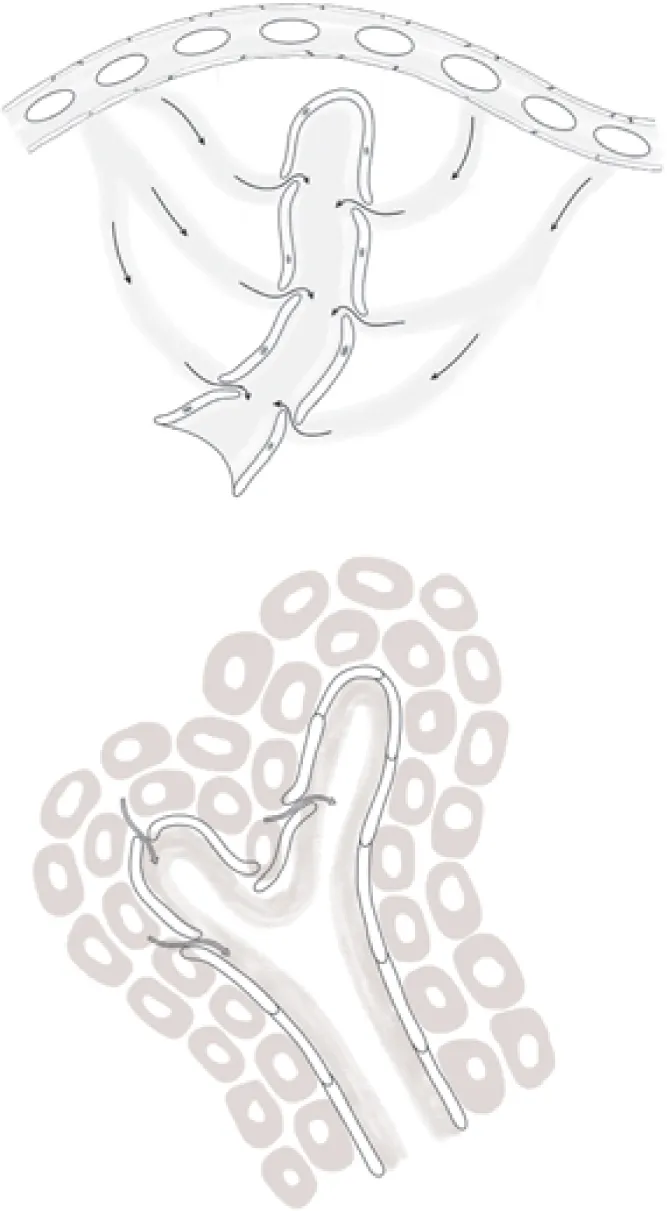Chapter 1
Rivers of Immunity
You’re already exercising. You’re eating healthfully. You’re balancing stress (or trying to!). But you still don’t feel great. I hear this every day in my practice. Clients come in with observations such as “Something doesn’t feel right,” “I’m tired all the time. I eat well, I sleep, I work out, I take supplements—but I have no energy,” “I’m always constipated,” and “I’ve tried everything, but I just feel out of sorts.”
Until recently, medical practitioners typically paid little attention to these kinds of comments, in part, I believe, because they are vague enough not to be potentially lethal symptoms of a major illness—even while they diminish quality of life. These symptoms are telling us something; they are evidence of imbalances. In my practice, I treat these concerns not as unimportant complaints but as clues to how to restore health. When I address a patient’s lymphatic health, such symptoms often abate, and my client experiences both physical and emotional improvements. This is because the lymphatic system is connected to every other system in the body—including the nervous system, the digestive system, and the neurological system—with branches that run through its wide geography like an intricate web of rivers. When it functions properly, you feel vibrant, energetic, and clear-headed. You’re able to digest and eliminate the food you eat, sleep well at night, and focus on what you need to accomplish during the day. You don’t get sick all the time, and you seem to breeze through cold and flu season.
When your lymphatic system is congested, on the other hand, you may feel lethargic and stuck. You may be constipated and headachey and experience more aches and pains than usual. It may seem as though you come down with a cold the instant anyone in your proximity sneezes. You might even be more anxious than usual for seemingly no reason. What you can’t see is that underneath the surface of your skin, the flow of your lymph “rivers” has likely slowed to a crawl, inhibiting organ function across your body. From your liver to your skin to your brain, all of your organs rely on the lymphatic system for optimal functioning.
Tending to your lymphatic health is as important as your daily flossing and brushing ritual; we know that we remove bacteria and plaque from our teeth to maintain good dental hygiene. Maintaining lymphatic health is like that: if you don’t tend to it consistently, problems can accumulate over time.
Think about how good you feel after cleaning your home, getting your car washed, or organizing your desk. Most people feel freer and lighter after such a cleanup. Once you’ve removed the grime, dispensed with the garbage, and tidied up your environment, new oxygen can flow through your space. Lymphatic self-massage does the same thing for you internally. It’s like a cleaning or tidying up for your body. You will feel lighter and more energized in just five minutes because you will have reduced the stressors that are causing congestion and stagnation. You will go from feeling stuck to being free flowing.
But before I teach you how to enjoy these benefits, let me walk you through the anatomy and function of your lymphatic system so you can better understand how it works and why it’s such a powerful force in your well-being.
BASICS OF THE LYMPHATIC SYSTEM
What is lymph, exactly, and why didn’t you learn about it in school when you were taught about your circulatory and digestive systems? Given how essential the lymphatic system is to your immune health, it’s staggering to me that most of us were taught virtually nothing about it! So let’s start with the basics.
There are two circulatory systems in your body:
Your cardiovascular system, which consists of your heart and your blood vessels. Your heart is at the center of this system, and its network distributes blood throughout the body. The blood vessels transport oxygen and nutrients to cells. Your arteries carry blood away from your heart, and your veins carry it back in a continuous loop through your cells, removing carbon dioxide and delivering vital nutrients that keep you alive and regulate your body temperature.
Your lymphatic system, considered to be your “second” circulatory system, is the sanitation and recycling system of your body. Just as you have two sets of pipes in your home—one set that brings in fresh water and another that removes dirty water—your lymphatic system is the bonus set of plumbing that filters and removes excess waste from your body. It’s approximately twice as vast as the cardiovascular system, but it doesn’t have a central pump like the heart to move the fluid around. Lymph flows in only one direction: toward your heart. Because it is not propelled by a master pump, its flow relies on the pulsing of nearby arteries, skeletal muscle contractions, and breathing. That’s why self-massage, breath work, and exercise are invaluable to good lymphatic health.
Your lymphatic system plays a number of critical roles in your body. It’s an essential part of the immune system, producing white blood cells with the power to destroy harmful pathogens. It acts as a garbage collector, filtering out bacteria and toxins that can cause disease. It aids the digestive system by absorbing fat and fatty acids from your gut and transporting them back to your bloodstream, making them available as fuel to your cells. And finally, it maintains the fluid balance in your body by collecting, purifying, and draining excess fluids so your tissues don’t swell. We’ll explore all of these valuable roles in more detail shortly, but first, let’s take a closer look at the intricate geography of the lymphatic system.
THE ANATOMY OF THE LYMPHATIC SYSTEM
Throughout your life, your lymphatic system continuously distributes immune cells across your body. When you look at the map of where your lymph flows, lymph nodes appear like gas stations along the highway of their vessel network. Lymph nodes are where the white blood cells called lymphocytes do their job of eliminating pathogens and harmful substances from the interstitial fluid—the fluid space between your cells—before it continues on its way to its final destination in the bloodstream.
The way lymph circulates through the body is in no way random; it is carefully mapped out. Lymphatic fluid moves inward from your extremities toward your heart. If you’ve studied geology, you know that rivers and streams collect water from one area and direct it toward a greater outlet such as an ocean. Your body is no different; your own pathways move lymphatic fluid like rivers, first to clusters of lymph nodes, then ultimately to your greater outlet: your bloodstream. Understanding these currents of the lymphatic system is critical to understanding why a lymphatic drainage massage is different from a typical deep-tissue massage. This will lay the foundation for cultivating your self-massage practice.
THE ATLAS OF LYMPH
When I see clients for the first time, I always show them this illustration. Most people have no idea that lymphatic vessels run through their entire body in a similar way to their blood vessels. Notice their systemic nature, the linked chain of vessels, capillaries, and ducts that run through nearly every inch of your body. The lymphatic system is an intricate network of vessels, capillaries, precollectors, collectors, and trunks that transport fluids from surrounding cells to lymph nodes. The nodes act as filtering stations, where white blood cells called macrophages and lymphocytes engulf and destroy harmful material before returning the fluid to the bloodstream, where it is eventually processed through the kidneys and liver and eliminated via bowel movements and urination.
Lymph is formed from the waste fluid of your body’s cells. Each day, fluid seeps out of your blood capillaries and into the interstitial fluid. Although some of it is reabsorbed by blood capillaries, the job of your lymphatic system is to collect the remaining fluid (also referred to as the lymph load), which is made up of waste that’s too big for your blood capillaries to absorb—including metabolic waste, proteins, hormones, fat-soluble vitamins, and immune cells—in order to prevent an accumulation of toxic debris in your tissues. That fluid enters the lymphatic system through tiny lymphatic capillaries shaped like fingers, located just underneath the top layer of your skin. Lymphatic capillaries are present all through your body, including in your digestive tract, reproductive system, and respiratory system. They have overlapping cells that open and close to absorb fluid, similarly to sponges or the way a plant’s root system draws water into itself. They are also permeable, which allows tissue fluid, bacteria, viruses, and cancer cells to enter the system for purification.
Lymphatic fluid is made up of approximately 50 percent nutrient-rich plasma proteins (plasma leaves the body’s cells after it has delivered its nutrients) as well as harmful invaders that your venous system isn’t able to re-collect. After the lymphatic fluid has been absorbed by the spongy capillaries, it travels through a series of one-way superficial lymphatic vessels toward the areas in your body where lymph nodes are located for purification. Your body transports approximately three liters (that’s six pints) of cleansed lymphatic fluid back into your bloodstream daily to start its journey all over again.
The way the lymphatic system captures the body’s cellular debris from your blood vessels is similar to the way rain gutters collect leaves and particles and rainfall runoff. If a gutter doesn’t work properly, germ-laden trash gets clogged up in it and then overflows in a heaping mess that ends up strewn all over your lawn.
LYMPH NODES
Your lymph nodes are the cornerstone of lymphatic massage. In the sequences in part II, you’ll learn how to massage the nodes, found in most hinges, or joints that allow movement in one direction, of your body: your head, neck, armpits, sternum, abdomen, the crease at the top of your thighs, your elbow creases, and behind your knees.
You have anywhere from five hundred to eight hundred lymph nodes throughout your body, typically grouped around veins in adipose, or fat, tissues. Your lymph nodes are where bacteria and viruses meet up with immune cells so that your body can mount a critical immune response. They may be no larger than a pea or a kidney bean, but they are constantly surveying your insides for nefarious activity. When they are healthy, their size varies from 2 millimeters to 2.5 centimeters in diameter. Lymph nodes don’t regenerate, so if any are surgically removed (typically due to cancer treatment), a mechanical insufficiency can result, impairing your body’s ability to eliminate excess lymphatic fluid. This can put you at risk of developing lymphedema and other disorders of the lymphatic system (I will discuss these conditions in detail in part II).
Lymphatic fluid is brought into the lymph nodes by afferent lymphatic vessels. There, macrophages get to work, straining bacteria out of the lymph. Then lymphocytes engulf and destroy other material they recognize as harmful. Lymphatic fluid can go through several lymph nodes before it’s fully cleaned out. Certain substances that cannot be wiped out (such as coals, dusts, and dyes) are stored in the node indefinitely.
Once the fluid has gone through this process, it reaches the efferent lymphatic vessels, which transport lymphatic fluid out of the nodes through a complex, one-way network of vessels and valves toward your heart, from which it is recirculated back into your bloodstream, toxin free. This is why lymph is sometimes referred to as “the great recycler”: It does for your body what you do for the environment when you place your household recycling ...




